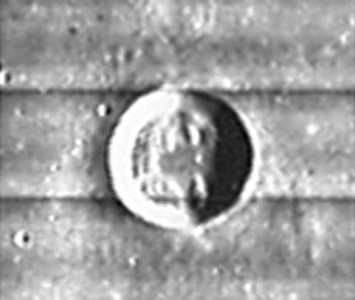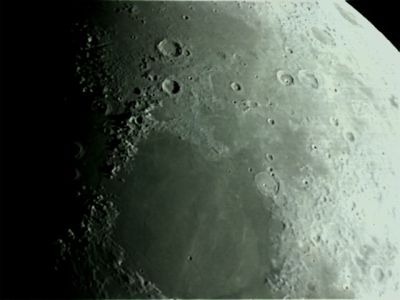Bessel
Contents
- 1 Bessel
Bessel
|
Lat: 21.73°N, Long: 17.92°E, Diam: 15.56 km, Depth: 1.77 km, Rukl: 24 |


Left: Lunar Orbiter 4-090-H3, Right: Simon J. Porter, Bessel is the small crater near the bottom of Mare Serenitatis.
Images
LPOD Photo Gallery Lunar Orbiter Images Apollo Images
- AS17-145-22271 and the four following photographs in Apollo 17's Magazine 145-D show close-ups of the Command Module America. In the background, near the lower left corner of this and the other four photographs, is crater Bessel and the remarkable ray-streak which runs over and alongside of it.
- Apollo 15's orbital panoramic ITEK-camera frames AS15-P-9902 and AS15-P-9907 show Bessel during high sun illumination (scroll to the right).
- Research orbital Apollo photography: Danny Caes
Maps
(LAC zone 42D2) LAC map Geologic map LM map LTO map
Description
Elger
(IAU Directions) BESSEL.--A bright circular crater, 14 miles in diameter, on the S. half of the Mare Serenitatis, and the largest object of its class thereon. Its floor is depressed some 2,000 feet below the surrounding surface, while the walls, rising nearly 1,600 feet above the plain, have peaks both on the N. and S. about 200 feet higher. The shadows of these features, noted by Schroter in 1797, and by many subsequent observers, are very noteworthy. I have seen the shadow of a third peak about midway between the two. One may faintly imagine the magnificent prospect of the coast- line of the Mare with the Haemus range, which would be obtained were it possible to stand on the summit of one of these elevations. It is doubtful whether Bessel has a central mountain. Neither Madler nor Schmidt have seen one, though Webb noted a peak on two occasions. I fail to see anything within the crater. The bright streak crossing the Mare from N. to S. passes through Bessel.
Wikipedia
Additional Information
- IAU page: Bessel
- Depth data from Kurt Fisher database
- Pike, 1976: 1.77 km
- Arthur, 1974: 1.74 km
- Westfall, 2000: 1.77 km
- Viscardy, 1985: 1.74 km
- Cherrington, 1969: 1.58 km
- Radar dark halo crater - tychocrater Oct 6, 2007
- Thermal anomaly crater, implying youthful age - Moore et al, 1980
- Included in ALPO list of bright ray craters
- Central peak height - Bessel A
- Wood, 1971: 0.034 km - tychocrater Mar 17, 2008
- TSI = 15, CPI = 5, FI = 15; MI =35 Smith and Sanchez, 1973
Nomenclature
- Named for Friedrich Wilhelm Bessel (July 22, 1784 – March 17, 1846), a German mathematician, astronomer, and systematizer of the Bessel functions.
- According to Whitaker (p. 219), this name was introduced by Mädler.
- Although the crater itself is depicted on it, the name BESSEL is absent on Philip's Moon Map; New Edition by John Murray and Peter Grego, 2003.- DannyCaes Apr 27, 2011
The Bessel Ray (the first named example of this kind of high-albedo rays?)
The 21st Century Atlas of the Moon (Charles A. Wood/ Maurice J.S. Collins) is perhaps the very first lunar atlas which has a name for the mysterious high-albedo ray running across Mare Serenitatis and crater Bessel. This ray is one of the most stubborn riddles in the history of moon observing and selenography. What is the source of this remarkable singular ray of ejecta? Is Bessel the source? Or is it a crater to the north of Mare Serenitatis? Or perhaps to the south?
It's very strange that this kind of pronounced rays (ejecta rays from impact craters) don't have official IAU names.
Anyway, Chart 11 (page 35) in the 21st Century Atlas of the Moon shows the informal name Bessel Ray just north of crater Bessel.
How many (ancient or recent) moonbooks have a description of the mysterious Bessel Ray in Mare Serenitatis?
- DannyCaes Aug 16, 2015
LROC Articles
LPOD Articles
Lunar 100
L41: Ray of uncertain origin near Bessel.
Bibliography
- Young, RA (1977). A stratigraphic model for Bessel crater and southern Mare Serenitatis. Impact and Explosion Cratering (Ed by Roddy, Peppin & Merrill), 527-538
- Drawing and text by Alika Herring. S&T January 1960, p. 169
- Apollo Over the Moon, Chapter 5: Craters (Part 4), Figure 145.
F. W. Bessel in the Sourcebook Project (William R. Corliss)
- In Mysterious Universe, a handbook of astronomical anomalies (1979) :
- Page 54: The Intra-Mercurial Planet Question (Nature, 1876). Note: in those days there was a lot to do about the supposed planet called "Vulcan", and almost every well-respected astronomer was involved in the investigation of this (so-called) Intra-Mercurial planet. To explore the large amount of Vulcan-related articles in Chapter 2 of Mysterious Universe is a most interesting and enjoyable pastime! - DannyCaes Mar 29, 2015
Named Features -- Prev: Bessarion -- Next: Bettinus